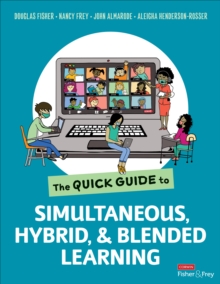Description
| Product ID: | 9781071851654 |
| Product Form: | Paperback / softback |
| Country of Manufacture: | US |
| Title: | The Quick Guide to Simultaneous, Hybrid, and Blended Learning |
| Authors: | Author: Aleigha Henderson-Rosser, Nancy Frey, John T. Almarode, Douglas Fisher |
| Page Count: | 120 |
| Subjects: | Educational strategies and policy, Literacy strategies, Teaching skills and techniques, Teaching skills & techniques |
| Description: | Select Guide Rating What a year! Twelve months and counting since COVID expanded, stretched, and blurred the boundaries of teaching and learning, at least one thing has remained constant: our commitment as educators to move learning forward. It’s just the context that keeps changing—why Doug Fisher, Nancy Frey, John Almarode, and Aleigha Henderson-Rosser have created a follow-up to The Distance Learning Playbook, their all-new Quick Guide to Simultaneous, Hybrid, and Blended Learning. First, to be clear: simultaneous learning must not be an additive, meaning we combine two entirely different approaches and double our workload. That’s unsustainable! Instead, we must extract, integrate, and implement what works best from both distance learning and face-to-face learning environments. Then and only then—Doug, Nancy, John, and Aleigha insist—can we maximize the learning opportunities for all of our students. To that end, The Quick Guide to Simultaneous, Hybrid, and Blended Learning describes how to:
“None of us chose to be in a situation where some learners are physically in our classrooms, while others attend virtually and remotely,” write Doug, Nancy, John, and Aleigha. “However, what we hope to convey is that we’ve got this! While the context is different, the principles behind clarity, planning, high-yield strategies and interventions, student learning, and assessment hold steady.” This is where The Quick Guide to Simultaneous, Hybrid, and Blended Learning will prove indispensable on this next leg of our journey. What a year! Twelve months and counting since COVID expanded, stretched, and blurred the boundaries of teaching and learning, at least one thing has remained constant: our commitment as educators to move learning forward. It’s just the context that keeps changing—why Doug Fisher, Nancy Frey, John Almarode, and Aleigha Henderson-Rosser have created a follow-up to The Distance Learning Playbook, their all-new Quick Guide to Simultaneous, Hybrid, and Blended Learning. First, to be clear: simultaneous learning must not be an additive, meaning we combine two entirely different approaches and double our workload. That’s unsustainable! Instead, we must extract, integrate, and implement what works best from both distance learning and face-to-face learning environments. Then and only then—Doug, Nancy, John, and Aleigha insist—can we maximize the learning opportunities for all of our students. To that end, The Quick Guide to Simultaneous, Hybrid, and Blended Learning describes how to:
“None of us chose to be in a situation where some learners are physically in our classrooms, while others attend virtually and remotely,” write Doug, Nancy, John, and Aleigha. “However, what we hope to convey is that we’ve got this! While the context is different, the principles behind clarity, planning, high-yield strategies and interventions, student learning, and assessment hold steady.” This is where The Quick Guide to Simultaneous, Hybrid, and Blended Learning will prove indispensable on this next leg of our journey. |
| Imprint Name: | Corwin Press Inc |
| Publisher Name: | SAGE Publications Inc |
| Country of Publication: | GB |
| Publishing Date: | 2021-06-30 |


